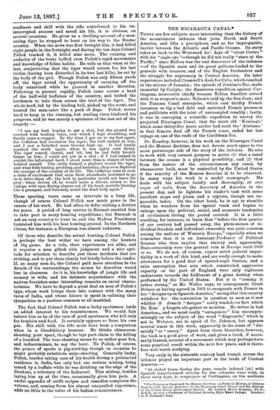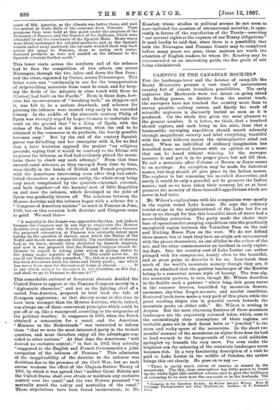THE NICARAGUA CANAL.*
THERE are few subjects more interesting than the history of the mountainous isthmus that joins North and South America, and lifts a precipitous, and so far impregnable,. barrier between the Atlantic and Pacific Oceans. Its story takes us back to the Westward ho ! days of "stout Cortez "' with his "eagle eye "—though he did not really "stare at the Pacific," since Balboa was the real discoverer of the isthmus —of the Spanish main and its great galleons loaded to the gunwale with treasure, and of the English freebooters and the struggle for supremacy in Central America. Its later experiences included Cromwell's dash for Cribs, which resulted in the seizure of Jamaica ; the episode of Jenkins's Ear, made immortal by Carlyle; the disastrous expedition against Car- thagena, memorable chiefly because Tobias Smollett served with it as surgeon's mate ; Nelson's raid up the San Juan; and the Panama Canal enterprise, which cost thrifty French investors so big a bad debt and smirched French pressmen and publicists with the taint of unexampled venality ; lastly, it was in conveying a scientific expedition to survey the projected Nicaragua Canal, that the stout old Kearsage,' which some thirty-five years earlier had sunk the 'Alabama' in that famous duel off the French coast, ended her last; voyage on one of the reefs of the Caribbean Sea.
Dr. Keasbey, however, in his work on the Nicaragua Canal and the Monroe doctrine, does not devote much space to the more picturesque side of the story of the isthmus. He sets to work with very earnest purpose to prove (1) that a canal between the oceans is a physical possibility, and (2) that from the nature of the circumstances any canal, by whomsoever built, must be controlled by the United States if the sanctity of the Monroe doctrine is to be observed. In many ways his work is a model monograph. He deals with his subject lucidly and thoroughly, ab ovis. usque ad mala, from the discovery of America to the present day, and he lightens his reader's task with some excellent maps and plans, and a copious, though not im- peccable, index. On the other hand, he is apt to stumble when he wanders from his special track and begins to enlarge upon the political, social, and economic tendencies of civilisation during the period covered. It is a little startling, for instance, to learn that "before the first quarter of our century had passed away, the phenomenon of in- dividual freedom and individual ownership was quite common among the nations of Western Europe," especially when we remember that it is an Assistant-Professor of Political Science who thus implies that slavery and, apparently, State-ownership were the general rule in Europe until 1800 or so. We do not, of course, expect strict judicial impar- tiality in a work of this kind, and are ready enough to make allowances for a good deal of spread-eagle fustian, and a calm assumption that acts which constituted aggressive rapacity on the part of England were only righteous endeavours towards the fulfilment of a great destiny when performed by the United States. But it is "coming it rather strong," as Mr. Weller says, to misrepresent Great Britain as having agreed in 1861 to co-operate with France in her "designs upon Spanish-America," seeing that this country withdrew fro . the convention in question as soon as it saw whither th Erench " designs " really tended,—a fact which Dr. Kew' ,y forgets altogether to mention. He writes in bad Americai.., and we must really " antagonize " him uncompro- misingly on the subject of the word "disgruntle," which is not in Webster, not to speak of Dr. Johnson, but appears several times in this work, apparently in the sense of "dis- satisfy " or "annoy." Apart from these blemishes, however,. the book is a good piece of work, and gives a lucid, if neces- sarily biassed, account of a movement which may perhaps have some practical result within the next few years, and is there- fore well worth studying.
Very early in the sixteenth century land transit across the isthmus played an important part in the trade of Central America :—
" At stated times during the year, vessels ladened [sic] with. Spanish manufactured articles for the colonists were wont, in these early days, to congregate at Carthagena, on the northern- • The Nicaragua Canal and the Monroe Doctrine: a Politico/ History of Isthmus Transit. vith Special Reference to the Nicaragua Canal Project and the Attitude of the United States Government thereto. By Lindley Milier Keasbey, Ph.D., As ocia- e Professor of Political Science, Bryn Mawr College. London:. U. P. Putuain's Sons.
coast of 8th. America, as the climate was better there, and wait the arrival at Porto Bello of the caravans from Panama. Then gorgeous fairs were held at this point under the auspices of the Governor of Panama and the General of the Galleons, which were attended by all the merchants of the Spanish Main. Home wares were there exchanged for colonial products, and as the Spanish vessels sailed away eastward, the ox-carts wended their way back across the range to Panama, there to reship such manu- factured products as were not needed on the isthmus to the Spanish colonists farther south."
This lower route across the southern end of the isthmus had to face the competition of two others, one across Nicaragua, through the two lakes and down the San Juan;
and the other, organised by Cortez, across Tehuantepec. This latter route was "continually in use for the transportation of ship-building materials from coast to coast, and for keep- ing the fleets of the Atlantic in close touch with those he [Cortez] had built on the Pacific." Even in those days, how- ever, the inconvenience of "breaking bulk," as shippers call it, was felt to be a serious drawback, and schemes for piercing the isthmus were mooted very early in its recorded history. In the middle of the sixteenth century Philip of Spain was strongly urged by Lopez Gomara to undertake the work on the ground that "to a King of Spain, with the riches of the Indies at his doorway, when the end to be obtained is the commerce in its products, the barely possible becomes easy." But by the end of the century Spanish power was dwindling and her enterprise with it, for we find that a later historian opposed the project "on religious grounds, saying that it would be contrary to the Divine will to pierce the isthmus, as God had evidently placed the moun- tains there to check any such attempt." From that time onward canal schemes, as they emerged from time to time, were chiefly in the hands of British and French projectors,
with the Americans intervening soon after they had estab- lished themselves as a separate entity, the whole story being very much complicated by the quarrels—internal, external, and both together—of the hornets' nest of little Republics on and near the isthmus, which developed as the yoke of Spain was gradually thrown off. The relations between the Monroe doctrine and the isthmus began with a scheme for a 4‘ Congress of American nations" to meet in Panama in June, 1826, but on this occasion both doctrine and Congress came to grief. We read that— "A majority in the Senate was opposed to the idea; not, indeed, because the Congress was in any way to emphasise the Monroe doctrine even against the Powers of Europe, but rather because the proposed convention at Panama was evidently intent upon taking up the question of slavery, upon which the States of the North and South were already divided. The institution of slavery had, as we know, already been abolished by Spanish America, and now it was proposed that the Panama Congress should de- liberate in regard to taking joint action in giving status to the young negro republic of Hayti. This could never be. As one of our Senators hotly remarked, No, this is a question which has been determined HERE for three and thirty years ; one which
has never been open for discussion at home or abroad It is one which cannot be discussed in this Chamber, on this day ; and shall we go to Panama to discuss it P' " This remarkable outburst of Senatorial rhetoric decided the United States to appear at the Panama Congress merely in a "diplomatic character," and not as the fighting chief of a united Pan-America, prepared to hurl back the tide of European aggression; so that slavery seems at this time to have been stronger than the Monroe doctrine, which, indeed, was always one of those convenient principles which could be put off or on, like a waterproof, according to the exigencies of the political weather. It reappears in 1830, when the Dutch obtained a concession for a canal, and the American "Minister to the Netherlands" was instructed to inform them "that we were the most interested party in the transit question, and must therefore enjoy all the advantages con- ceded to other nations." At that time the Americans "still desired no exclusive control ; " in fact in 1862 they actually "suggested to the English and French Governments a joint tempation of the isthmus of Panama." This admission of the inapplicability of the doctrine to the isthmus was doubtless due to the presence of the Civil War, but no such excuse weakens the effect of the Clayton-Bulwer Treaty of 1850, by which it was agreed that "neither Great Britain nor the United States shall ever obtain or maintain any exclusive control over the canal," and the two Powers promised "to
mutually guard the safety and neutrality of the canal." These stipulations have been found inconvenient, so Dr.
Keasbey, whose studies in political science do not seem to have included the question of international morality, is appa- rently in favour of the repudiation of the Treaty—asserting "our natural rights at the expense of our Treaty obligations." It need hardly be said that, since there is a possibility that both the Nicaragua and Panama Canals may be completed before many years are gone, these matters are worth the attention of English readers, to whom Dr. Keasbey may be recommended as an interesting guide, the due grain of salt being administered.



































 Previous page
Previous page